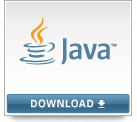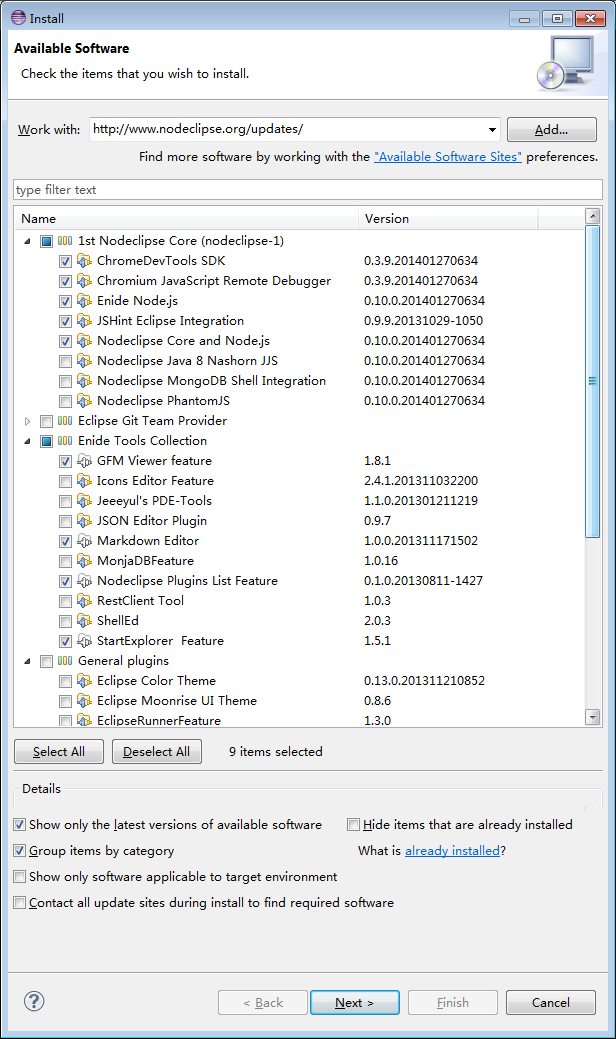prerequisites
In short words, install Node.js with needed packages, Java and Eclipse package like Enide 2015:
- 1.
If you don't have, get latest Node.js or io.js
- 2. Then install
Nodeclipse CLI
and Express with Express' application generator$ npm install -g nodeclipse
$ npm install -g express
$ npm install -g express-generator
If you are going to use CoffeeScript, do$ npm install -g coffee-script
- 3.
 If you don't have, download & install JDK 8 from
Oracle Java SE Downloads.
For example "Java Platform (JDK) 8u162".
If you don't have, download & install JDK 8 from
Oracle Java SE Downloads.
For example "Java Platform (JDK) 8u162".
There are issues with Java 7 and 6 #71 #72 and newer Java 9 or 10.
Note 0: If you don't know what version is used by Eclipse, check in Preferences -> Nodeclipse.
The Eclipse most recommended way to configure what JDK to use is to configure ineclipse.ini.
- 4.a Get
Enide 2015 with all Nodeclipse plugins included.
see also Enide 2015-7
for win32
win32
 win64
win64
 MacOS X
MacOS X
 Linux
Linux
See all SourceForge downloads.served.
See java-start and android-start pages.
That is enough for Node.js, JavaScript and Java development.
For existing Node.js project you can runnodeclipse -pto add project files and then import as existing project.
For any project or folder you can runnodeclipse -gand then import as existing project (this will add only 1.projectfile).
See Usage.
You can update to the latest version later and install even more from Nodeclipse Updates repository, see "b) update site".
- 4.b or Download and install Eclipse for your OS.
Recommended is "Eclipse IDE for Committers" (actually it is Standard/SDK),
"Eclipse IDE for Java Developers" or "Eclipse for Java/DSL Developers".
You can also install Nodeclipse/Enide plugins into
Aptana Studio
(see issue #181),
Red Hat JBoss Developer Studio,
STS Spring Tool Suite
or other Eclipse-based software
like Adobe Flash Builder, IBM Rational products and SAP NetWeaver Developer Studio.
Installation\Update Instructions
(for Eclipse or Enide [Studio]) In short words, drag-and-drop on Eclipse main toolbar and get Enide 2015 plugins.
on Eclipse main toolbar and get Enide 2015 plugins.
a) Marketplace (Recommended way: a bit quicker)
1. Start Eclipse.
2. Drag and drop
 into a running Eclipse (menu area) to install Nodeclipse.
into a running Eclipse (menu area) to install Nodeclipse.
See tip how
2. Review the features that you are about to install. Click Next.
3. Read the license agreements,
and then select I accept the terms of the license agreements. Click Finish.
4. You will then be asked if you would like to restart Eclipse. Click Restart Now.
5. Switch to Node perspective (e.g. Window -> Open Perspective -> Other ... -> Node).
6. Now you are ready to develop Node.js applications with Nodeclipse!
b) update site (bigger choice)
1. Start Eclipse, then select Help > Install New Software...
2. Enter the update site URL into the Work with text box:
https://nodeclipse.github.io/updates/
or the one that is quicker but changes every release
http://dl.bintray.com/nodeclipse/nodeclipse/1.0.2f/
Select with checkbox what you want to install.
("The more, the better" does not apply here.
Take note of what features names you are installing.)
Below is Enide-Recommended-Set-for-Nodejs for example.

3. Uncheck "Contact all updates site during install to find required software"
to make installation quicker.
Note that different Eclipse version have different behaviour for that checkbox.
Press the Enter key or Next button.
4. After a while depending of what you had and what you selected,
you should see the center box filled with Eclipse plugins to install.
Click Next.
5. Review the features that you are about to install. Click Next.
6. Read the license agreements,
and then select I accept the terms of the license agreements. Click Finish.
7. You will then be asked if you would like to restart Eclipse. Click Restart Now.
8. Switch to Node perspective (e.g. Window -> Open Perspective -> Other ... -> Node).
9. Now you are ready to develop Node.js applications with Nodeclipse and great tools!
c) Archive (when Internet is slow, not stable or installing many times)
zip archive has content identical to update p2 site
0. Download zip from SourceForge.
1. Start Eclipse.
2. Help -> Install New Software -> Add -> Archive.
Hint for b) & c): keep the file name the same when updating, or remove old path and URLs as Eclipse keeps checking them.
d) Enide p2f file
0. Read more at Marketplace page.
e) Nodeclipse CLI Installer
0. Read more at GitHup page.
1. cd path/to/eclipse
2. nodeclipse install nodejs markdown gfm startexplorer
3. Start Eclipse.
Updating
If you used http://dl.bintray.com/nodeclipse/nodeclipse/1.0.2f/ like URL or update site zip archive,
you will just need to install with any above option.
(Also you will need to clean up old update sites in Preferences -> Update/Install -> Available Software Sites.)
Otherwise Eclipse "Help -> Check for updates" should work.
You will be notified about updates if you have "Automatic Updates" enabled in Preferences.
Check home page for announces and news about new plugins and workflow.
Reset perspective after an update for new UI elements to appear:

If you have run into the problem while updating, e.g. "#72", 1) let us know by raising new issue (tell exactly what OS, Java version, Eclipse version and Nodeclipse version is used.) 2) Update to latest JDK. 3) Uninstall then install: 3.1) Uninstall Nodeclipse Core (only 1 feature entry) via Help -> About Eclipse -> Installation details, select Nodeclipse, then Uninstall.. button 3.2) install again.
Troubleshooting
If you can't install, try different way to get Nodeclipse, e.g. other update site, Enide or Enide Studio. Check home page for announcements. Try support options.





